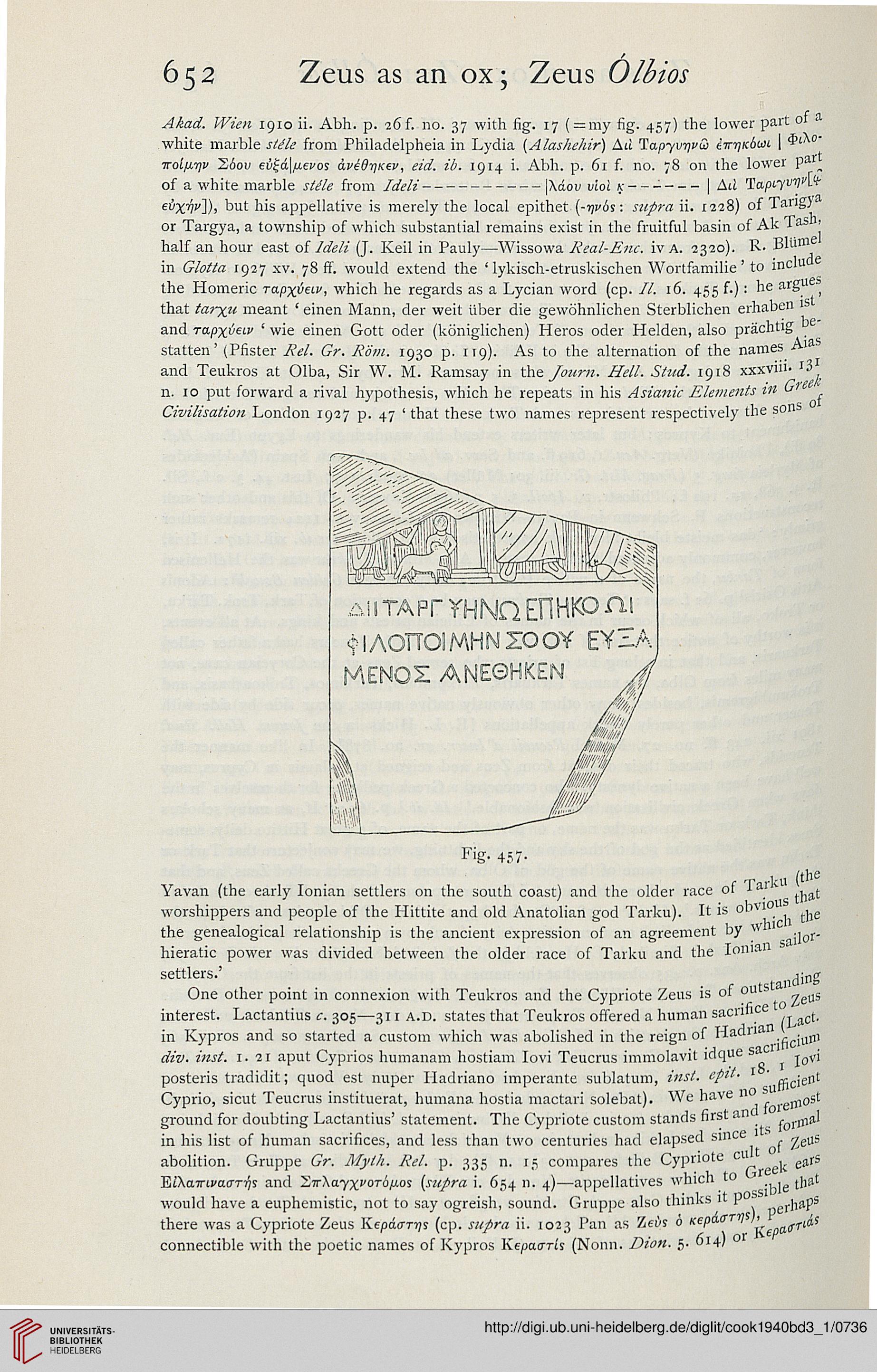652
Zeus as an ox; Zeus Olbios
Akad. Wien 1910 ii. Abh. p. 26 f. no. 37 with fig. 17 ( = my fig. 457) the lower part of a
white marble stile from Fhiladelpheia in Lydia (Alasliehir)
wolnnv 26ou ei£d\/i.ei'os avtdrjKev, eid. ib. 1914 i. Abh. p. 61 f. no. 78 on the lower par'
of a white marble stile from Ideli----------\\dov viol k---:---| Ail Tapiyvvlt-
^XV"]), but his appellative is merely the local epithet (-?)k6s: supra ii. 1228) of Tarig}'a
or Targya, a township of which substantial remains exist in the fruitful basin of Ak Tash,
half an hour east of Ideli (J. Keil in Pauly—Wissowa Real-Enc. iv A. 2320). R. BHimel
in Glotta 1927 xv. 78 ff. would extend the ' lykisch-etruskischen Wortfamilie' to include
the Homeric rapxitiv, which he regards as a Lycian word (cp. //. 16. 455 f.): he argues
that tarxu meant ' einen Mann, der weit Uber die gewohnlichen Sterblichen erhaben 1st
and rapxveiv ' wie einen Gott oder (koniglichen) Heros oder Helden, also prachtig be-
statten' (Pfister Rel. Gr. Rom. 1930 p. 119). As to the alternation of the names Aias
and Teukros at Olba, Sir W. M. Ramsay in the Journ. Hell. Stud. 1918 xxxviii- 13'
n. 10 put forward a rival hypothesis, which he repeats in his Asianic Elements in Gree'
Civilisation London 1927 p. 47 ' that these two names represent respectively the sons 0
tlAOnOIMHNZOOY EY-A
KENOS ANE9HKEN Jf
Fig- 457-
TarkU (the
Yavan (the early Ionian settlers on the south coast) and the older race or ta t
worshippers and people of the Hittite and old Anatolian god Tarku). It is obvio° ^
the genealogical relationship is the ancient expression of an agreement by W aj[0r-
hieratic power was divided between the older race of Tarku and the Ionian
settlers.' nding
One other point in connexion with Teukros and the Cypriote Zeus is of ontstt ^
interest. Lactantius c. 305—31 r a.d. states that Teukros offered a human sacrifice
in Kypros and so started a custom which was abolished in the reign of Hadrian.^_cjuiij
div. inst. 1. 21 aput Cyprios humanam hostiam Iovi Teucrus immolavit idque saci ^
posteris tradidit; quod est nuper Hadriano imperante sublatum, inst. eptt. 1 ■ ^c\enl
Cyprio, sicut Teucrus instituerat, humana hostia mactari solebat). We have no s
ground for doubting Lactantius' statement. The Cypriote custom stands first an ^orIn»
in his list of human sacrifices, and less than two centuries had elapsed since - geus
abolition. Gruppe Gr. Myth. Rel, p. 335 n. tg compares the Cypriote cl^eek ears
EiAo.Trii'aoTTjs and 'Zir\ayxvoTbp.os (supra i. 654 n. 4)—appellatives which to ^ ^ ^at
would have a euphemistic, not to say ogreish, sound. Gruppe also thinks it p°= rjj»Ps
there was a Cypriote Zeus Kepdo-njs (cp. supra ii. 1023 Pan as Zeus 6 KepaffTV fT^s
connectible with the poetic names of Kypros Kepaaris (Nonn. Dion. 5. 6J4) or
Zeus as an ox; Zeus Olbios
Akad. Wien 1910 ii. Abh. p. 26 f. no. 37 with fig. 17 ( = my fig. 457) the lower part of a
white marble stile from Fhiladelpheia in Lydia (Alasliehir)
wolnnv 26ou ei£d\/i.ei'os avtdrjKev, eid. ib. 1914 i. Abh. p. 61 f. no. 78 on the lower par'
of a white marble stile from Ideli----------\\dov viol k---:---| Ail Tapiyvvlt-
^XV"]), but his appellative is merely the local epithet (-?)k6s: supra ii. 1228) of Tarig}'a
or Targya, a township of which substantial remains exist in the fruitful basin of Ak Tash,
half an hour east of Ideli (J. Keil in Pauly—Wissowa Real-Enc. iv A. 2320). R. BHimel
in Glotta 1927 xv. 78 ff. would extend the ' lykisch-etruskischen Wortfamilie' to include
the Homeric rapxitiv, which he regards as a Lycian word (cp. //. 16. 455 f.): he argues
that tarxu meant ' einen Mann, der weit Uber die gewohnlichen Sterblichen erhaben 1st
and rapxveiv ' wie einen Gott oder (koniglichen) Heros oder Helden, also prachtig be-
statten' (Pfister Rel. Gr. Rom. 1930 p. 119). As to the alternation of the names Aias
and Teukros at Olba, Sir W. M. Ramsay in the Journ. Hell. Stud. 1918 xxxviii- 13'
n. 10 put forward a rival hypothesis, which he repeats in his Asianic Elements in Gree'
Civilisation London 1927 p. 47 ' that these two names represent respectively the sons 0
tlAOnOIMHNZOOY EY-A
KENOS ANE9HKEN Jf
Fig- 457-
TarkU (the
Yavan (the early Ionian settlers on the south coast) and the older race or ta t
worshippers and people of the Hittite and old Anatolian god Tarku). It is obvio° ^
the genealogical relationship is the ancient expression of an agreement by W aj[0r-
hieratic power was divided between the older race of Tarku and the Ionian
settlers.' nding
One other point in connexion with Teukros and the Cypriote Zeus is of ontstt ^
interest. Lactantius c. 305—31 r a.d. states that Teukros offered a human sacrifice
in Kypros and so started a custom which was abolished in the reign of Hadrian.^_cjuiij
div. inst. 1. 21 aput Cyprios humanam hostiam Iovi Teucrus immolavit idque saci ^
posteris tradidit; quod est nuper Hadriano imperante sublatum, inst. eptt. 1 ■ ^c\enl
Cyprio, sicut Teucrus instituerat, humana hostia mactari solebat). We have no s
ground for doubting Lactantius' statement. The Cypriote custom stands first an ^orIn»
in his list of human sacrifices, and less than two centuries had elapsed since - geus
abolition. Gruppe Gr. Myth. Rel, p. 335 n. tg compares the Cypriote cl^eek ears
EiAo.Trii'aoTTjs and 'Zir\ayxvoTbp.os (supra i. 654 n. 4)—appellatives which to ^ ^ ^at
would have a euphemistic, not to say ogreish, sound. Gruppe also thinks it p°= rjj»Ps
there was a Cypriote Zeus Kepdo-njs (cp. supra ii. 1023 Pan as Zeus 6 KepaffTV fT^s
connectible with the poetic names of Kypros Kepaaris (Nonn. Dion. 5. 6J4) or




